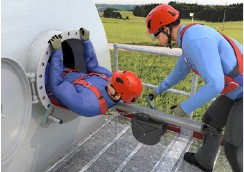Abschnitt 6.1 - 6 Emergency and rescue measures
6.1 Measures for rescue from vessels, silos and confined spaces
6.1.1
The employer must keep suitable rescue and transport equipment ready for rescue from
vessels, silos and confined spaces.
The employer whose personnel are working in the vessel, silo or confined space is responsible for rescue. In many cases, personnel and equipment for rescue are made available by the operator of the vessel, silo or confined space.
Where personnel from multiple companies work simultaneously or at staggered intervals in a vessel, silo or confined space, the parties responsible must coordinate and document (for example on the permit) who is to perform rescue should it be necessary.
Refer also to Section 25 of DGUV Regulation 1, "Principles of prevention" and DGUV Informative publication 213-055 governing rescue from vessels, silos and confined spaces.
Section 11 (2) 2 of the German Ordinance on industrial safety and health (BetrSichV) requires the necessary anchoring facilities for rescue equipment to be provided on and in work equipment.
Since rescue must usually be performed swiftly, the equipment must be kept ready at all times where it will be needed. Maintaining rescue equipment ready at a central point in the company, for example at the works fire service, is advantageous only when effects of hazardous substances or an oxygen deficit during work in the vessels, silos and confined spaces can be ruled out.
Rescue personnel may enter vessels, silos or confined spaces without breathing apparatus only if it is ensured that hazardous concentrations of hazardous substances or an oxygen deficit are not present.
The use of rescue equipment is subject to DGUV Rule 112-199 governing rescue from above and below.
The following equipment may be suitable for rescue in a horizontal direction:
Rescue basket
 | Should a risk of falling exist, personal protective equipment against falls from a height must be used in addition, or equipment must be used that combines protection against falls from a height with the rescue function (such as fall arresting devices with rescue lift function, see Section 4.10). |
|---|
Where the personal protective equipment is used for rescue, the person to be rescued is drawn out of the vessel, silo or confined space by means of a rescue harness.

Fig. 26
Access from the side by means of a special fixture on the rescue lifting device
Swift rescue is generally assured only if this person has already donned the rescue harness before the commencement of work. Should pressing reasons exist for the worker not to don the rescue harness before entering the vessel, silo or confined space, other measures must be planned that permit swift rescue. Possible measures in this context are:
Provision of suitable respiratory protection equipment by means of which rescue crews are able to reach and rescue the insured persons in distress without delay
Provision of equipment that enables the interior of the vessel to be accessed quickly, such as equipment for cutting open the vessel wall
Work in vessels, silos and confined spaces without a permanent connection between the rescue equipment and the rescue harness should be the exception. Pressing reasons for the harness not to be connected permanently to the rescue equipment include:
The performance of work simultaneously by several persons in the vessel, silo or confined space (which may quickly lead to mutual obstruction when several ropes are used)
Equipment installed within the vessels, silos or confined spaces that may entrap the rope
The circumstances in the case at hand, for example frequent changes of direction
6.1.2
The parties involved, particularly the safety persons, must be instructed in the use
of the rescue equipment. The measures required for rescue of persons in distress must
be drilled in a practical manner at regular intervals and at least once a year.
6.1.3
Complex situations require the production of a written rescue plan.
6.1.4
Where the rescue plan provides for the involvement of rescue personnel from outside
the plant in rescue measures, these personnel must take part in the drills referred
to in Section 6.1.2.
